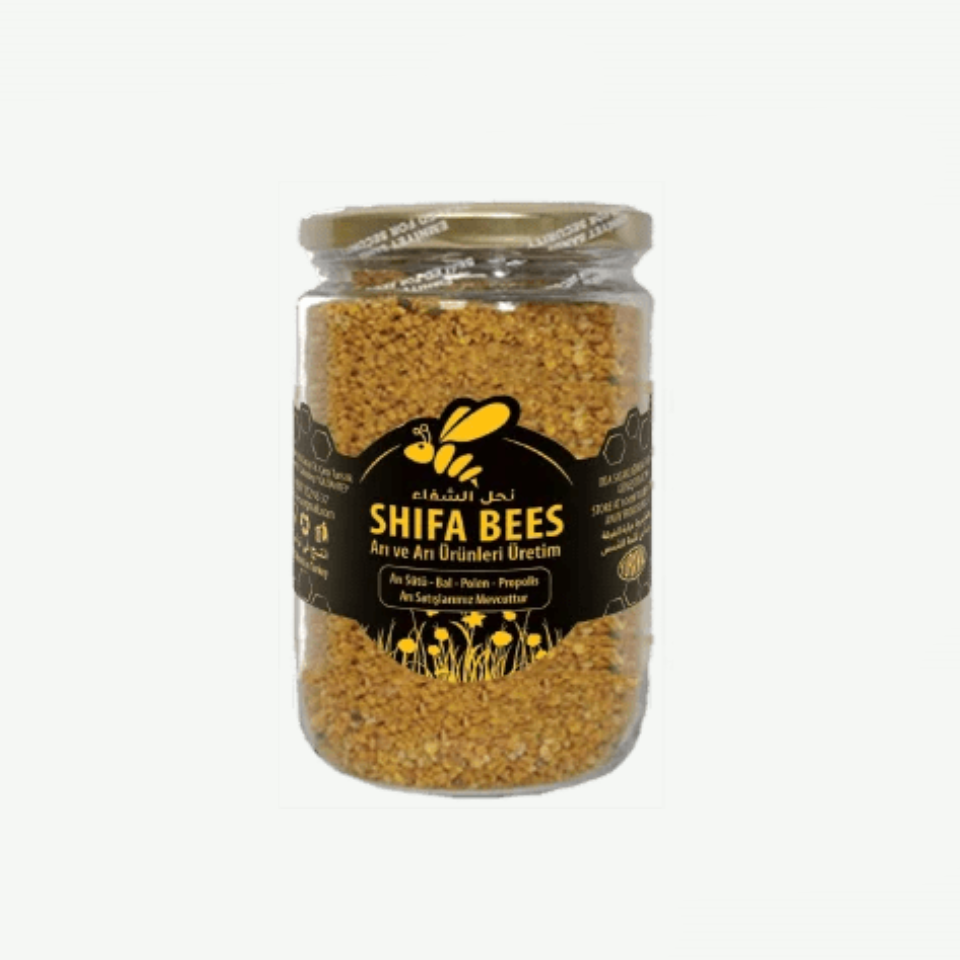1. Pollen source:
The workers collect pollen from the flowers of different plants, mix them with a small dose of salivary gland secretion or nectar, put them in pollen baskets on the hind legs and transfer pollen grains to the hive. The color of pollen varies from light yellow to black.
2. Chemical composition of pollen
Pollen is a diverse plant product rich in biologically active substances. 200 substances are found in pollen from different plant species.
There are proteins, amino acids, carbohydrates, lipids, fatty acids, phenolic compounds, enzymes and coenzymes, as well as vitamins and vital elements.
Pollen contains an average of 22.7% protein, including 10.4% of the essential amino acids such as methionine, lysine, threonine, histidine, leucine, isoleucine, valine, phenylalanine, and tryptophan. These protein elements are essential for life and an organism cannot make them on its own. Moreover, in pollen, there are large amounts of nucleic acids, especially RNA. Digestible carbohydrates occur in pollen at an average rate of 30.8%. Reducing sugars, especially fructose and glucose, are present in this product in about 25.7%
Among the fats contained in pollen in an amount of about 5,1%, those that should be mentioned in the first place are the essential fatty acids (EFAs). Acids such as linoleic, gamma-linoleic and archaic exist in the amount of 0,4%. The percentage of phospholipids is up to 1.5%, while phytosterols, especially P-sitosterol, are present at 1.1% [16].
Another group accounted for phenolic compounds that amount to 1.6% on average. This group includes flavonoids, leukotrienes, catechins, and phenolic acids. Among the flavonoids present in pollen in 1.4%, there is mainly kaempferol, quercetin, and isorhamantin, while in the group of phenolic acids, 0.2%, mainly chlorogenic acid is found [17].
Pollen is characterized by a very important content of triterpene bonds. The most common compounds are oleanolic acids, 3-ursolic acid, and betulin alcohols [12, 13]. Moreover, vitamins and bioelements also belong to valuable substances.
Pollen is an important source of 0.1% fat-soluble vitamins, such as vitamin A, vitamin E and D, and 0.6% water soluble, such as B1, B2, B6, C, and acids: pantothenic, nicotine, folic, biotin, rutin, and inositol. . Their total amount is equal to 0.7% in the entire product.
Vital elements are present in about 1.6%, including macronutrients (calcium, phosphorous, magnesium, sodium, potassium) and micronutrients (iron, copper, zinc, manganese, silicon, and selenium). The latter is present in the amount of 0.02% [10 – 13].
The average content of the main components in air-dried pollen (at a temperature of 40 ° C) reaches the following values: proteins, 32,8%, including essential amino acids, 11,5%, and reducing sugars, 40.7%, Including sucrose, 3.7%, fat, 12.8%, vitamin C, 0.19%, beta-carotene, 0.07%, prebiotics, 4.0%.
3. Activity and biological properties of pollen
Experimental pharmacokinetic studies, conducted on rats and rabbits, showed that pollen has an activity that reduces the content of total plasma lipids and triglycerol. In addition, a lower serum lipid concentration is associated with the content of hormones such as insulin, testosterone and thyroid hormone that are responsible for increasing lipid metabolism [19, 20].
Clinical studies confirmed the hypolipidemic activity of pollen. It made the content of the above-mentioned fatty substances decrease in the serum of patients from 20 to 35% [21]. It has also been successfully applied in the treatment of hyperlipidemia and atherosclerosis. In patients who did not react to the anti-sclerotic drug, Grofibrat (fenofibratum), the pollen lowered lipids and cholesterol by 20 to 30% and reduced platelet aggregation by 30% [22, 23]. In atherosclerotic patients with significant myopia and partial atrophy of the optic nerve, pollen lowered serum cholesterol level, increased field of vision and stabilized visual acuity [24].
Pollen and its extracts, especially fat-soluble ones, are successfully applied in post-infarction cases as well as in systemic circulatory disorders and arterial hypertension. Moreover, small doses of pollen administered to the elderly allow to inhibit atherosclerotic changes in blood vessels and improve cerebral blood flow [25].
The hypoglycemic activity of pollen is mainly attributed to the presence of unsaturated fatty acids, phospholipids, and phytosterols. Furthermore, decreased platelet aggregation capacity and increased activity of the fibrinolytic system have been confirmed in people taking pollen. It refers to the anti-atherosclerotic effect that protects against heart disease and strokes [26].
Extensive and well-documented animal studies have also unequivocally demonstrated the detoxifying action of pollen. Mice were poisoned with organic solvents such as carbon tetrachloride and trichloroethylene, as well as ethionine and ammonium fluoride, both of which caused profound damage to hepatocytes, galactosamine, which mimics changes in viral hepatitis, and ethanol, and allyl alcohol, resulting in severe damage to hepatocytes. Steatosis and cirrhosis of the liver and with drugs: paracetamol and hydrocortisone. Under their influence, very high levels of enzymes such as alanine and aspartate transaminase, acid phosphatase, and bilirubin were evaluated [27]. Pollen lowered the level of these substances in the blood serum even to physiological values, which proves the healing properties of this product in reference to liver tissue. However, when ingested with toxic substances, it protects liver cells from their harmful effect, which in turn indicates its ability to prevent poisoning. In the detoxification process, polyphenols play an important role, especially flavonoids and phenolic acids [28 – 31].
The detoxification activity of pollen and bee bread should also be mentioned in phenomena such as occupational diseases, heavy metal contamination, industrial gases and dust, and drugs (eg antirheumatic, anti-inflammatory and antibiotic preparations) [32].
Pollen is also characterized by high anti-inflammatory activity. Its size is compared to NSAIDs such as naproxen, analgin, phenylbutazone, or indomethacin [33].
The mechanism of the anti-inflammatory effect is the inhibition of the activity of cyclooxygenase and lipoxygenase, the enzymes responsible for the conversion of arachidonic acid into toxic compounds such as prostaglandins and leukotrienes, which leads to the development of acute and chronic inflammatory conditions in tissues. Experimental research showed that a concentrated extract of pollen, at a dose of 50 mg to a rat’s body weight, eliminated 75% of the animal’s foot swelling caused by ingestion of carrageenan. The elements responsible for this activity are flavonoids and phenolic acids as well as fatty acids and phytosterols [34]. Pollen is recommended in cases of acute and chronic infections, primary degenerative conditions, hepatobiliary diseases as well as in toxic and post-traumatic damage to this organ [33, 34].
Bee pollen has also been suggested as a valuable dietary supplement. Animal feeding experiments with pollen have also been conducted. It has been shown that mice and rats fed pollen showed higher levels of vitamin C and magnesium in the thymus, myocardium, and skeletal muscle as well as a higher hemoglobin content and a higher number of red blood cells than animals given the standard feed. . Moreover, pollen also extended the lifespan of experimental animals [35–37].
Pollen causes you to gain weight faster than a normal diet. The research proved that pollen has high nutritional value as well as the property of quick supplement to nutritional deficiency in animal organisms. The components that play a vital role in this process are amino acids, vitamins, and vital elements that can be dispensed with [36, 38].
The nutritional properties of pollen and regulated metabolic processes are used, among other things, in cases of poor appetite in children, growth retardation, malnutrition of children and adults. Moreover, it is recommended to give pollen in the recovery period, after surgeries, and for people who work hard both physically and mentally [36, 38].
Moreover, the adaptive properties of pollen were also noted, which are based on increased resistance to adverse physical, chemical and biological factors: they (1) increase the fitness of the organism under excessive physical load, affecting the center. nervous system by improving brain functions, such as memory, learning, comprehension, reasoning, and ability to focus, and (2) increasing the strength of the immune system against infection in the way of boosting the immune system [39].
Ethanol extracts from pollen have also been shown to have strong antibiotic activity that is still effective on pathogens of Gram-positive human bacteria, for example, Staphylococcus aureus, and Gram-negative bacteria, including Escherichia coli, Klebsiella pneumoniae, Pseudomonas aeurgionsa, and on fungi. Like candida albicans. The responsibility for this activity lies in flavonoids and phenolic acids [40, 41].
Recent research indicates that pollen has anti-allergic activity. It protects the mast cells of living organisms from degradation caused by the release of histamine, which is the mainstay of allergic reactions. For example, the release of histamine from mast cells, induced by serum containing antibody, was inhibited


Reviews
There are no reviews yet.